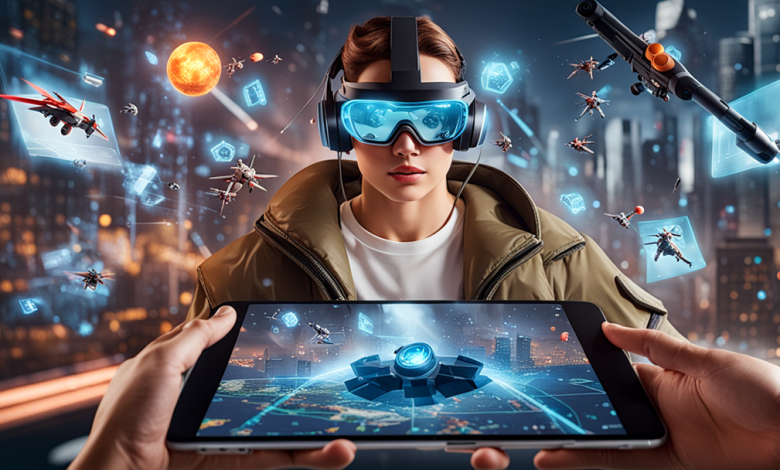Augmented Reality in Gaming: Transforming Entertainment and Interaction
Transforming Entertainment and Interaction

Introduction:
The world of gaming has always been at the forefront of technological innovation, constantly pushing the boundaries of what’s possible. In recent years, augmented reality (AR) has emerged as a groundbreaking technology that is revolutionizing the gaming industry. By seamlessly blending virtual elements with the real world, AR gaming offers immersive experiences that engage players in entirely new ways.
The Rise of Augmented Reality Gaming:
The advent of smartphones equipped with powerful processors, high-resolution cameras, and advanced sensors laid the groundwork for the widespread adoption of AR gaming. One of the most notable early successes in this space was Niantic’s Pokémon GO, which took the world by storm upon its release in 2016. The game allowed players to explore their surroundings in search of virtual Pokémon creatures, superimposed onto the real world via their smartphone screens. Pokémon GO demonstrated the immense potential of AR gaming to captivate players and create shared experiences on a global scale.
The Rise of Augmented Reality Gaming:
A New Era of Interactive Entertainment:
In recent years, augmented reality (AR) gaming has emerged as a dynamic and captivating form of interactive entertainment, capturing the imagination of millions around the globe. Augmented reality seamlessly merges virtual elements with the real world, creating immersive gaming experiences that blur the lines between fiction and reality. This technological innovation has not only transformed the way we play games but has also opened up new possibilities for social interaction, exploration, and adventure.
Origins and Early Innovations:
The roots of augmented reality gaming can be traced back to the convergence of advancements in mobile technology, computer vision, and location-based services. One of the earliest and most influential examples of AR gaming is the phenomenon that swept the world in 2016: Pokémon GO. Developed by Niantic in collaboration with Nintendo and The Pokémon Company, Pokémon GO took the concept of augmented reality mainstream, captivating players of all ages with its unique blend of virtual creatures and real-world exploration. Pokémon GO leveraged the GPS capabilities of smartphones to place Pokémon characters in real-world locations, allowing players to encounter and capture them using their device’s camera. The game’s success demonstrated the immense potential of AR gaming to engage players in interactive experiences that transcend the confines of traditional gaming environments.
Engaging Gameplay Experiences:
Augmented reality gaming offers a level of immersion and interactivity that is unparalleled in traditional gaming experiences. By overlaying virtual elements onto the real world, AR games encourage players to venture outside and explore their surroundings in search of adventure. Whether it’s hunting for virtual creatures, solving location-based puzzles, or competing in multiplayer battles, AR gaming brings a new dimension of excitement and discovery to the gaming experience. One of the key appeals of augmented reality gaming is its ability to foster social interaction and community engagement. Games like Pokémon GO encourage players to collaborate with others, form teams, and participate in large-scale events and competitions. These shared experiences create opportunities for players to connect with fellow gamers in their local communities, forging friendships and building social bonds through a shared passion for gaming.
Innovative Technology and Gameplay Mechanics:
Augmented reality gaming leverages a range of cutting-edge technologies to create immersive and interactive experiences. Advanced computer vision algorithms enable devices to recognize and track real-world objects and environments, while GPS and sensor data provide location-based context for gameplay. Augmented reality glasses and headsets offer a hands-free AR experience, allowing players to interact with virtual elements without being tethered to a smartphone or tablet. The innovative gameplay mechanics of AR gaming are limited only by the imagination of game developers. From location-based scavenger hunts and treasure hunts to interactive storytelling experiences and multiplayer battles, AR games offer a diverse range of gameplay experiences that appeal to players of all ages and interests. Whether it’s exploring virtual worlds overlaid onto real-world locations or collaborating with friends to conquer virtual challenges, AR gaming offers a level of immersion and engagement that is unmatched by traditional gaming experiences.
Challenges and Future Directions:
While augmented reality gaming has seen significant growth and popularity in recent years, it still faces several challenges that must be addressed for continued success. Technical limitations, such as battery life, device compatibility, and the accuracy of GPS and sensor data, can impact the quality of the AR experience. Additionally, concerns related to privacy, safety, and security must be carefully considered to ensure the responsible development and deployment of AR gaming technologies. Looking ahead, the future of augmented reality gaming is full of promise. Advances in hardware, software, and networking technologies will further enhance the immersive capabilities of AR gaming experiences. From augmented reality theme parks and location-based multiplayer games to immersive storytelling experiences and educational applications, the possibilities for AR gaming are limited only by our imagination.
Conclusion:
The rise of augmented reality gaming represents a new era of interactive entertainment, where players can explore virtual worlds overlaid onto their physical surroundings and engage in immersive experiences that transcend the boundaries of traditional gaming environments. As technology continues to evolve and improve, augmented reality gaming is poised to become an integral part of the gaming landscape, inspiring creativity, fostering social interaction, and pushing the boundaries of what’s possible in interactive entertainment.
Engaging Gameplay Experiences:
One of the key appeals of augmented reality gaming is its ability to merge the virtual and physical worlds, transforming ordinary environments into dynamic gaming spaces. AR games encourage players to venture outside and explore their surroundings, fostering a sense of adventure and discovery. By leveraging GPS data and real-world landmarks, AR games can generate location-based content that reacts to the player’s movements and interactions, creating immersive gameplay experiences that unfold in real time.
Engaging Gameplay Experiences: The Heartbeat of Gaming
In the vast and diverse landscape of gaming, one factor stands out as paramount: engaging gameplay experiences. At its core, gaming is about more than just graphics or storyline—it’s about the interactive journey players embark upon, the challenges they face, and the satisfaction they derive from overcoming obstacles. Engaging gameplay experiences are the heartbeat of gaming, driving players to immerse themselves in virtual worlds, explore new horizons, and connect with others in ways that transcend the boundaries of reality.
Immersive Environments:
One of the hallmarks of engaging gameplay experiences is the creation of immersive environments that captivate players from the moment they enter the game. Whether it’s a sprawling open world teeming with life and detail or a tightly scripted narrative set in a meticulously crafted universe, immersive environments draw players in and make them feel like an integral part of the game world. From the bustling streets of a futuristic metropolis to the serene beauty of a fantastical landscape, immersive environments transport players to new realms of imagination and adventure.
Dynamic Gameplay Mechanics:
Engaging gameplay experiences are characterized by dynamic gameplay mechanics that challenge players to think creatively, adapt to changing circumstances, and master new skills. From fast-paced action sequences that test reflexes and coordination to strategic decision-making that requires careful planning and foresight, dynamic gameplay mechanics keep players on their toes and ensure that every moment is filled with excitement and anticipation. Whether it’s navigating treacherous obstacles, outwitting cunning adversaries, or exploring hidden secrets, dynamic gameplay mechanics provide endless opportunities for discovery and growth.
Meaningful Player Choices:
Another key element of engaging gameplay experiences is the inclusion of meaningful player choices that shape the outcome of the game world and the narrative arc of the story. Whether it’s deciding the fate of a troubled kingdom, forging alliances with rival factions, or determining the moral compass of the protagonist, meaningful player choices empower players to become active participants in the unfolding drama of the game. By giving players agency to influence the course of events, meaningful player choices create a sense of ownership and investment in the outcome of the game, driving players to explore every avenue and uncover every possibility.
Compelling Narrative:
Engaging gameplay experiences are often anchored by a compelling narrative that draws players into a rich tapestry of characters, conflicts, and plot twists. Whether it’s an epic saga spanning multiple generations or an intimate character-driven story focused on the struggles of a single protagonist, a compelling narrative provides context and motivation for the player’s actions, imbuing every moment with a sense of purpose and significance. From heart-wrenching tragedies to triumphant victories, a compelling narrative weaves together the threads of the game world, immersing players in a story that resonates long after the credits roll.
Social Interaction and Community Engagement:
Finally, engaging gameplay experiences often extend beyond the confines of the game itself, fostering social interaction and community engagement among players. Whether it’s teaming up with friends to tackle challenging raids and dungeons, competing against rivals in fierce PvP battles, or sharing tips and strategies with fellow enthusiasts, social interaction adds an extra layer of depth and enjoyment to the gaming experience. From online forums and social media groups to fan conventions and esports tournaments, gaming communities provide a vibrant and dynamic ecosystem where players can connect, collaborate, and celebrate their shared passion for gaming.
Conclusion:
Engaging gameplay experiences are the lifeblood of gaming, fueling players’ imaginations, challenging their skills, and connecting them with others in meaningful and memorable ways. From immersive environments and dynamic gameplay mechanics to meaningful player choices and compelling narratives, engaging gameplay experiences offer a rich tapestry of experiences that captivate players and keep them coming back for more. As gaming continues to evolve and innovate, one thing remains clear: the power of engaging gameplay experiences to inspire, entertain, and enchant players will always be at the heart of the gaming experience.
Social Interaction and Community Engagement
AR gaming has a unique ability to bring people together and foster social interaction. In games like Pokémon GO, players can join forces to conquer virtual gyms, participate in large-scale events, and connect with fellow trainers in their local communities. These shared experiences not only enhance the enjoyment of the game but also create opportunities for players to form friendships and build communities based on their shared interests.
Social Interaction and Community Engagement in Gaming: Building Bonds Beyond the Screen
Gaming has evolved far beyond the solitary activity it once was. Today, social interaction and community engagement are fundamental aspects of the gaming experience, shaping how players connect, collaborate, and compete in virtual worlds. From cooperative quests and multiplayer battles to online forums and fan conventions, gaming communities provide a vibrant and dynamic ecosystem where players come together to share their passion, forge friendships, and build bonds that extend far beyond the confines of the digital realm.
The Power of Connection:
At its core, gaming is a social activity—a means of bringing people together from all walks of life to share in the joy of play. Whether it’s teaming up with friends to tackle challenging raids, competing against rivals in fierce PvP battles, or simply sharing stories and strategies with fellow enthusiasts, gaming provides a platform for social interaction and connection unlike any other. Through the shared experiences of gaming, players form bonds based on mutual interests, camaraderie, and a shared sense of adventure.
Online Communities and Forums:
In the digital age, online communities and forums have become central hubs for gamers to connect and interact with one another. From dedicated subreddits and Discord servers to gaming forums and social media groups, these online spaces provide a platform for players to discuss their favorite games, share tips and strategies, and engage in lively debates about the latest gaming news and developments. Online communities foster a sense of belonging and camaraderie among players, creating a supportive and inclusive environment where everyone can feel welcome.
Cooperative Gameplay:
Cooperative gameplay is a cornerstone of social interaction in gaming, allowing players to team up with friends or strangers to achieve common goals and overcome shared challenges. Whether it’s coordinating tactics in a raid, strategizing in a multiplayer battle, or working together to solve puzzles in a cooperative adventure game, cooperative gameplay fosters teamwork, communication, and collaboration among players. The sense of accomplishment that comes from working together to achieve a common objective strengthens bonds and fosters a sense of camaraderie among teammates.
Competitive Gaming and Esports:
While cooperative gameplay emphasizes teamwork and collaboration, competitive gaming and esports celebrate skill, strategy, and competition. From intense 1v1 duels to large-scale tournaments with millions of dollars in prize money on the line, competitive gaming offers players the opportunity to test their skills against the best of the best and showcase their talents on a global stage. Esports events bring together players and fans from around the world, fostering a sense of community and camaraderie among participants and spectators alike.
Offline Events and Fan Conventions:
In addition to online interactions, gaming communities often come together in the real world at fan conventions, gaming expos, and other offline events. These gatherings provide an opportunity for players to meet face-to-face, forge new friendships, and celebrate their shared love of gaming. From cosplay contests and panel discussions to meet-and-greets with game developers and live esports tournaments, offline events offer a chance for gamers to connect with one another in a fun and welcoming environment.
Positive Impact and Social Good:
Beyond the realm of entertainment, gaming communities have the power to make a positive impact on the world around them. From charity livestreams and fundraising events to volunteer initiatives and community outreach programs, gamers often come together to support causes they care about and make a difference in their communities. Gaming communities have raised millions of dollars for charity organizations, contributed to disaster relief efforts, and promoted awareness of important social issues, demonstrating the potential of gaming to bring people together for a greater purpose.
Conclusion:
Social interaction and community engagement are integral parts of the gaming experience, enriching the lives of players and fostering connections that extend beyond the screen. Whether it’s bonding with friends over a shared love of gaming, collaborating with teammates to achieve victory, or coming together with fellow enthusiasts at a fan convention, gaming communities provide a vibrant and inclusive space where everyone can belong. As gaming continues to evolve and innovate, one thing remains clear: the power of social interaction and community engagement to unite players and build lasting friendships will always be at the heart of the gaming experience.
Innovative Gameplay Mechanics:
Augmented reality opens up new possibilities for innovative gameplay mechanics that take advantage of the player’s physical environment. For example, AR games may incorporate environmental elements such as terrain, weather conditions, and time of day to create dynamic challenges and puzzles. Players may need to navigate obstacles in the real world, solve location-based riddles, or collaborate with other players to overcome virtual adversaries. These immersive gameplay mechanics blur the line between reality and fiction, offering a truly unique gaming experience.
Innovative Gameplay Mechanics: Pushing the Boundaries of Gaming Creativity:
In the ever-evolving landscape of gaming, innovative gameplay mechanics stand out as the driving force behind the industry’s continued growth and evolution. From groundbreaking innovations that redefine how we interact with virtual worlds to subtle tweaks that enhance immersion and player engagement, innovative gameplay mechanics push the boundaries of creativity and imagination, transforming gaming experiences into unforgettable journeys of discovery and adventure.
Dynamic Environments and Emergent Gameplay:
One of the hallmarks of innovative gameplay mechanics is the creation of dynamic environments that react and adapt to player actions in real-time. Instead of following a predetermined script, dynamic environments present players with a sandbox of possibilities, allowing them to experiment, explore, and create their own stories. Whether it’s the unpredictable weather patterns of a survival game, the evolving political landscape of a strategy game, or the emergent gameplay opportunities of a sandbox RPG, dynamic environments provide endless opportunities for discovery and experimentation.
Procedural Generation and Randomization:
Procedural generation is another innovative gameplay mechanic that has gained popularity in recent years. By using algorithms to generate game content on the fly, procedural generation creates dynamic and ever-changing game worlds that are unique to each playthrough. From randomly generated levels and quests to procedurally generated enemies and loot, procedural generation adds an element of unpredictability and replayability to games, keeping players coming back for more as they explore new challenges and discover hidden treasures.
Player Agency and Choice:
Innovative gameplay mechanics often emphasize player agency and choice, allowing players to shape the outcome of the game world through their actions and decisions. Whether it’s choosing between different dialogue options that affect the course of the story, customizing character abilities to suit individual playstyles, or deciding the fate of in-game factions and characters, player agency gives players a sense of ownership and investment in the game world, driving them to explore every avenue and uncover every possibility.
Time Manipulation and Rewind Mechanics:
Time manipulation mechanics have become increasingly popular in recent years, allowing players to manipulate the flow of time within the game world to their advantage. Whether it’s rewinding time to correct mistakes, slowing down time to gain a tactical advantage in combat, or pausing time to plan out strategies, time manipulation mechanics add a new layer of depth and complexity to gameplay, challenging players to think creatively and adapt to changing circumstances.
Physical Interaction and Immersive Technologies:
The rise of immersive technologies such as virtual reality (VR) and augmented reality (AR) has opened up new possibilities for innovative gameplay mechanics that blur the lines between the virtual and physical worlds. From using motion controllers to interact with virtual objects in VR games to overlaying digital information onto the real world in AR games, immersive technologies provide a more tactile and immersive gaming experience that engages the player’s senses on a whole new level.
Collaborative Gameplay and Social Interaction:
Innovative gameplay mechanics also extend to collaborative gameplay and social interaction, allowing players to team up with friends or strangers to achieve common goals and overcome shared challenges. Whether it’s coordinating tactics in a multiplayer battle, solving puzzles together in a cooperative adventure game, or competing against rival teams in an online tournament, collaborative gameplay mechanics foster teamwork, communication, and camaraderie among players, creating memorable experiences that are best shared with others.
Conclusion:
Innovative gameplay mechanics are at the heart of gaming creativity, driving the industry forward and pushing the boundaries of what’s possible in interactive entertainment. Whether it’s dynamic environments that react and adapt to player actions, procedural generation that creates endless possibilities for exploration, or time manipulation mechanics that add a new layer of depth to gameplay, innovative gameplay mechanics enrich gaming experiences and inspire players to embark on unforgettable journeys of discovery and adventure. As gaming continues to evolve and innovate, one thing remains clear: the power of innovative gameplay mechanics to captivate players and fuel their imagination will always be at the forefront of gaming innovation.
Expanding the Boundaries of Gaming:
Beyond traditional mobile gaming experiences, augmented reality is also making waves in other gaming platforms. AR-enabled smart glasses and headsets, such as Microsoft’s HoloLens and Magic Leap One, offer more immersive AR experiences by overlaying digital content directly onto the user’s field of view. These devices open up new possibilities for AR gaming, allowing for hands-free interaction and a deeper integration of virtual elements into the player’s surroundings.
Challenges and Future Developments:
While augmented reality gaming has made significant strides in recent years, it still faces several challenges that must be addressed for continued growth and innovation. Technical limitations, such as battery life, device compatibility, and the accuracy of GPS and sensor data, can impact the quality of the AR experience. Additionally, concerns related to privacy, safety, and security must be carefully considered to ensure the responsible development and deployment of AR gaming technologies.
Looking ahead, the future of augmented reality gaming is full of promise. Advances in hardware, software, and networking technologies will further enhance the immersive capabilities of AR gaming experiences. From augmented reality theme parks and location-based multiplayer games to immersive storytelling experiences and educational applications, the possibilities for AR gaming are limited only by our imagination.
Conclusion:
Augmented reality gaming represents a paradigm shift in interactive entertainment, offering players the opportunity to explore and interact with virtual worlds overlaid onto their physical surroundings. By combining cutting-edge technology with innovative gameplay mechanics, AR gaming is reshaping the way we play, connect, and experience the world around us. As the technology continues to evolve, augmented reality gaming is poised to become an integral part of the gaming landscape, inspiring creativity, fostering social interaction, and pushing the boundaries of what’s possible in interactive entertainment.











